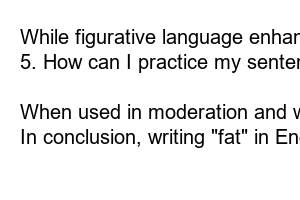지방 쓰는 방법
Title: Discover the Art of Writing “Fat” in English: A Comprehensive Guide
Introduction:
Are you seeking ways to enhance your English writing skills and make your text more engaging and impactful? Look no further! In this blog post, we will explore the intricacies of writing “fat” in English. By incorporating creative language techniques, structuring your sentences effectively, and mastering the art of wordplay, you can transform your writing into a captivating masterpiece.
1. What Exactly is “Fat” Writing?
“Fat” writing refers to the use of descriptive and expressive language to convey a message effectively. It involves using vivid vocabulary and crafting sentences that are comprehensive, engaging, and bursting with life. Rather than relying on plain and ordinary expressions, it employs colorful language elements to deliver a powerful impact.
2. Injecting Vivid Language:
By incorporating a myriad of expressive words into your writing, you can bring depth and flavor to your text. Utilize strong adjectives and adverbs to paint a vivid picture, engaging your readers’ senses and immersing them in the narrative. Expansive vocabulary ensures that your content resonates with your audience, leaving a lasting impression.
3. Structuring Effective Sentences:
Crafting concise yet energetic sentences is crucial to maintaining the flow and impact of your writing. By keeping sentences under 20 words, you can ensure clarity and prevent readers from losing their train of thought. Employing active voice further enhances your writing by fostering a direct and engaging connection with the reader.
4. Harnessing the Power of Wordplay:
Integrating wordplay and figures of speech can add depth and creativity to your writing. Using metaphors, similes, alliteration, and personification can truly captivate your audience. These techniques generate memorable and enjoyable reading experiences, making your content stand out.
5. Summary:
In summary, mastering the art of “fat” writing in English involves infusing your text with vivid language, employing effective sentence structures, and harnessing the power of wordplay. By following these guidelines, you can elevate your writing skills and create captivating content that leaves a lasting impact on your readers.
FAQs:
1. How can I expand my vocabulary to improve my “fat” writing skills?
To expand your vocabulary, read extensively, focusing on different genres and styles. Utilize a dictionary and thesaurus, and make a conscious effort to learn and incorporate new words into your writing.
2. Can I use “fat” writing techniques in professional writing?
Absolutely! Employing expressive language and creative techniques can enhance any type of writing, making it more engaging and enticing to your audience.
3. How can active voice improve my writing?
Active voice provides clarity and directness, enabling your readers to easily comprehend your message. It also enhances the connection between the writer and reader, making the writing more dynamic.
4. Is it necessary to use figurative language in every sentence?
While figurative language enhances your writing, it is important to strike a balance. Overusing it may distract the reader and dilute the impact. Incorporate it where it adds value and highlights important ideas.
5. How can I practice my sentence structuring skills?
To improve your sentence structuring skills, regularly engage in writing exercises. Focus on varying sentence lengths and use active voice to make your writing more concise and engaging.
6. Can colorful language be overwhelming for the reader?
When used in moderation and with purpose, colorful language captivates readers. However, excessive use may overshadow the main message. Strive for the right balance to ensure a pleasant reading experience.
In conclusion, writing “fat” in English involves a creative blend of vivid language, effective sentence structures, and imaginative wordplay. By incorporating these techniques into your writing, you can breathe life into your words and deliver an impactful message that resonates with your audience.

